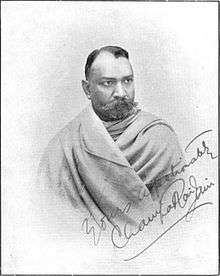Jain law
Jain law or Jaina law is the modern interpretation of ancient Jain law that consists of rules for adoption, marriage, succession and death prescribed for the followers of Jainism.
| Part of a series on |
| Jainism |
|---|
 |
|
Jain prayers |
|
Ethics |
|
Major sects |
|
Texts |
|
Festivals
|
|
|
History
Ancient
Jains regard Bharata Chakravartin as the first law giver of the present half cycle of time.[1] Jains have their own law books. Vardhamana Niti and Ashana Niti by the great Jain teacher Hemachandra deals with Jain law.[2] Bhadrabahu Samhit is also considered an important book on Jaina law.
Modern
In 1916, Barrister Jagomandar Lal Jaini (1881-1927) published a translation of Bhadrabahu Samhita, which went on to form the basis of modern Jain law. The author mentioned the full text of a judgement that he delivered in Civil Original Case No. 6 o f1914, Indore, in which Jain religious and legal scriptures were explicitly quoted and relied upon.[3] It has been suggested that Jain mendicants kept Jain lawbooks away from the British because of the Jain laws of purity.[4] Jain lawgivers had taken great pains to define violence, and were clear that no form of violence was permitted for Jain mendicants. The lawgivers were not so clear on the conduct of Jain laymen, assuming that a violent situation would not arise amongst a community that was numerically small.[4]
After the Montagu Declaration in 1917, the Jain Political Association was set up by the same circle of predominately Digambara Jain intellectuals to create a unitary political representation for the Jains. In due course the society intended, after due search of the śāstric literature, to give a definite shape to Jaina Law.[5] The culmination of this effort was the most prominent book on the subject of Jain law, written by Champat Rai Jain.[6]
In 1955, the Government of India subsumed Jain law under Hindu law, though Jain law continues in unofficial and semi-official fora.[7]
Adoption
In 1927, Madras High Court in Gateppa v. Eramma and others reported in AIR 1927 Madras 228, the court held that in Bhadrabahu Samhita, verse 40 empowers a sonless man or woman to take a boy in adoption. Verse 83 empowers a widow to adopt a boy and make over her property to him. Verse 73 was quoted in the judgement[8]-
The virtuous lady may like her husband take to herself a son of a good gotra and instal him on the estate of her husband.
Marriage
Jain Agamas mention that there are five types of marriages.[9]
Rights of female heirs
The rights of female heir in Jaina law are different from that of Hindu Law. Under the Jaina Law females take the inheritance absolutely.[10]
Succession
Upon the death of a person without a son, the property is entirely passed on to the widow. The property remains with the widow even if there were to be a son. This is an important difference between Jain law and Hindu law. In Hindu law, the widow does not have the right to the deceased husband's property. In Jainism, there is no privilege accorded to a male heir, and a widow is treated as a preferential heir to her own son.[11]
Twin sons
According to Jain law, in case of twin born sons, the first born or the eldest is entitled for more privileges at the time of partition.[1]
Death
Gallery
 Champat Rai Jain, author of the modern Jaina Law
Champat Rai Jain, author of the modern Jaina Law- The Householder's Dharma
See also
Citations
- Jain 2004, p. i.
- Jain, Champat Rai (1974), Fundamentals of Jainism
- Derrett, John Duncan Martin (1978), Essays in Classical and Modern Hindu Law: Current problems and the legacy of, ISBN 9004057536
- Sharafi, Mitra (21 April 2014), Law and Identity in Colonial South Asia, ISBN 9781139868068
- https://www.soas.ac.uk/research/publications/journals/ijjs/file40123.pdf
- Gel, Peter Fl; Flügel, Peter (1 February 2006), Studies in Jaina History and Culture, ISBN 9781134235520
- Flügel, Peter (1 February 2006), Studies in Jaina History and Culture, ISBN 9781134235513
- "(Bobbaladi) Gateppa vs (Bobbaladi) Eramma And Ors. on 13 August, 1926". Retrieved 23 February 2016.
- Caillat, Colette; Balbir, Nalini (1 January 2008), Jaina Studies, ISBN 9788120832473
- Jain 2004, p. xvi.
- Sangave, Vilas Adinath (1980), Jaina Community, ISBN 9780317123463
References
- Jain, Champat Rai (2004), Selections from the Jaina law, Jaina Vidyā Saṁsthāna
Further reading
- Flügel, Dr. Peter, A Short History Of Jaina Law